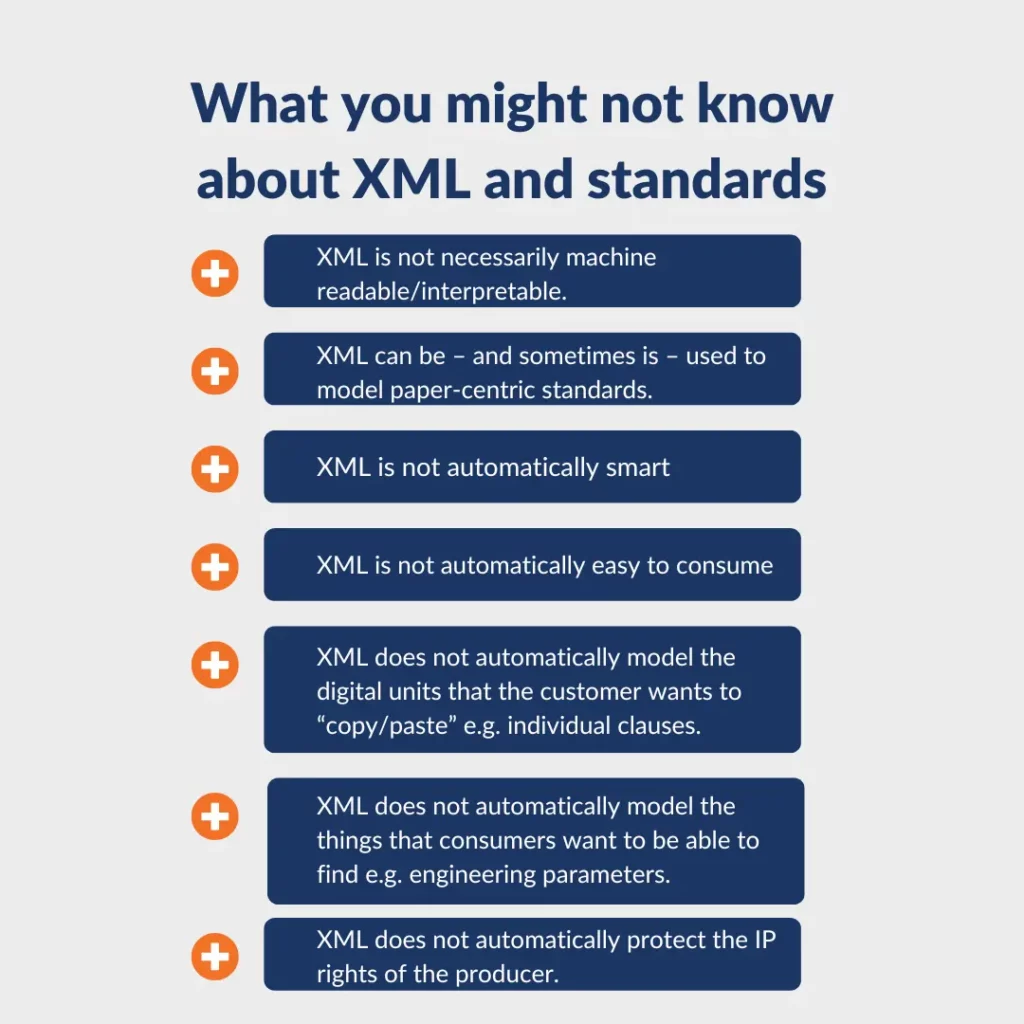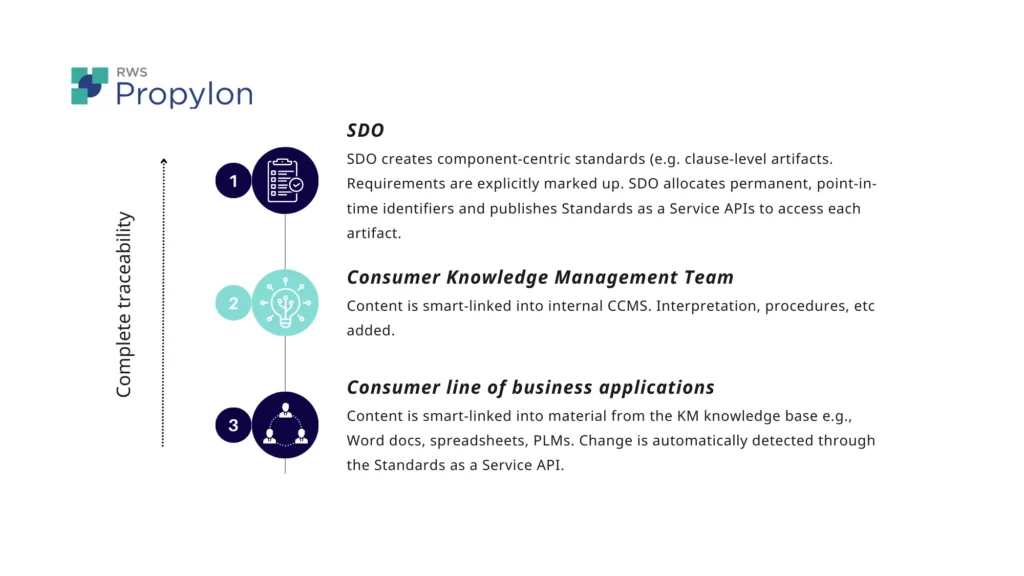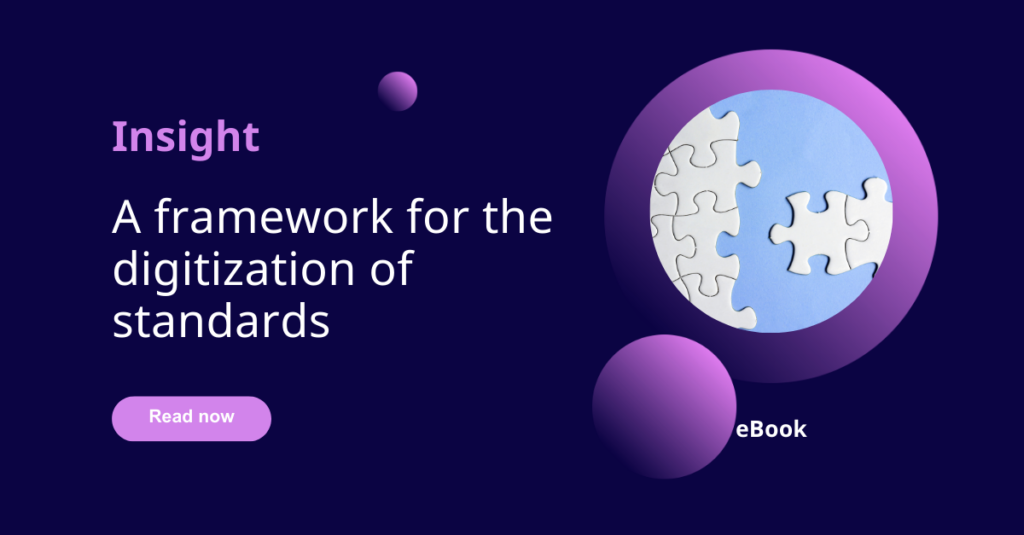Mounting regulations, increasing pressure to keep up to date and a need for traceability are just some of the challenges facing standards consumers.
Today, the value chain from the production to the consumption of standards is largely digital – computers are prevalent. However, the digital model utilized is largely based on paper and ink binding concepts that date back to the printing press. Thus, standards are managed with paper-centric digital tools such as the PDF.
A key difference between a book like a novel and a standard, is that standards are not read – they are used.
Heavily regulated enterprises read standards for the purposes of informing the creation of further documents elsewhere in the value chain such as requirements specifications, procedure manuals, training materials, etc. They need to be able to demonstrate to regulators and other stakeholders how, for example, a part on the workshop floor came to be made in a certain way, in accordance with the standard that governs it.
Copy and paste is the prevailing method of using digital standards. But copy and paste is not a sustainable solution for anyone, neither the producers of standards nor the consumers.
Today’s standards users have pressing re-use problems that cannot wait for the realization of machine-interpretable standards. The good news is that SDOs are best placed to meet these needs and can do so in a way that protects IP and without moving away from Microsoft Word.
Conceptualizing smart standards
The IEC/ISO model of smart standards outlines a seven-step evolution from paper and PDF, through XML to machine-interpretable, Standards as a Service and finally, future extensions.
However, there are key considerations to this route. XML is an excellent way to make content flexible, reusable, and provide a single source of truth. Yet, XML editors can introduce complexity for subject matter experts (SMEs) which is not always worth the cost it incurs. SMEs are typically Microsoft Word users and accustomed to the user-friendly environment.
Further, XML alone is not automatically smart, nor is it necessarily machine-readable or interpretable. Indeed, you might be asking yourself what does make a standard ‘smart’? We define a standard as smart if the actionable aspects of the standard can be ingested into the line of business applications (the downstream systems, documents, requirements) of a digitally sophisticated consumer in ways that unlock the value of the standard for both the producer and the consumer.
Today’s standards users have pressing re-use problems that cannot wait for the realization of machine-interpretable standards before Standards as a Service can be achieved. The good news is that standards development organizations (SDOs) are best placed to meet these needs and can do so in a way that protects IP and without moving away from Microsoft Word. The answer lies in componentization.

Reimagining the delivery model for standards
Componentization is a method of structuring your content into small snippets or components. This approach gives SDOs control at a micro scale, which benefits both the organization and its customers – be they a large consumer of standards or a small consumer. Additionally, time-aware technology gives SDOs the ability to associate permanent point-in-time identifiers to each component. This allows for each snippet to be fully tracked across its lifecycle.
We define a standard as smart if the actionable aspects of the standard can be ingested into the line of business applications (the downstream systems, documents, requirements) of a digitally sophisticated consumer in ways that unlock the value of the standard for both the producer and the consumer.
1. Large consumer scenario
Large consumers of standards usually have an internal knowledge management function. The knowledge management team reads all the content and operationalizes it across the business, disseminating into internal content such as requirements, policies, manuals.
Reimagining the delivery model for a large consumer of standards starts with the SDO creating component-centric standards, which could be, for example, a clause-level artifact. This material can then be internalized into the knowledge management team’s content management system and accordingly applied to the line of business applications – the Word documents, Excel spreadsheets, PLMs, etc. Changes can be automatically detected and added across this material while retaining its link to the master standard as managed by the SDO.

2. Small consumer scenario
Smaller consumers are less likely to have an internal knowledge management function. In this scenario, the consumption of SDO material occurs directly into the line of business applications, all the while retaining its link to the original standard and automatically detecting change.
Standards as a service in the near future
Componentization and XML editors are often thought to go hand-in-hand – the optimal way to gain advantages like content reuse and single source of truth. But a component content management system (CCMS) integrated with Microsoft Word lets your SMEs continue to work with familiar tools while giving your organization the ability to manage content at a micro level and reap the benefits of XML which the platform manages under the hood. There is no need to retrain SMEs or persuade them to undergo a steep learning curve.
Flexibility is key to serving the unique interests of both SDOs and its consumers. To that end, Propylon’s TimeArc® platform provides different API formats to allow your SDO to fast-track its evolution toward smart digital standards and Standards as a Service. Want to see for yourself how it works using Microsoft Word? Book a demo today.




